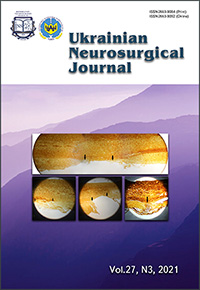Rigid endoscopic surgery of brainstem cavernous malformation on the cerebral aqueduct. Case report
DOI:
https://doi.org/10.25305/unj.232304Keywords:
endoscopic surgery; cavernoma; cavernous angioma; brainstem; cerebral aqueduct; triventriculocisternostomy; hydrocephalusAbstract
Cavernous angiomas (malformations) of the brain occur in 0.5% of the population. Most of them are asymptomatic, but due to their anatomical features, namely escape of blood into surrounding tissues, significant neurological symptoms can occur. The deep location of cavernous angiomas in the area of cerebral aqueduct makes surgical intervention difficult.
Microsurgical approaches are the gold standard in removal of cavernous angiomas, but they are associated with certain surgical risks in the formation of the surgical corridor. Cavernous malformations in the cerebral aqueduct are a rare subtype. Due to anatomical localization and concomitant obstructive hydrocephalus ІІІ and lateral ventricles, they can be removed by endoscopic frontal transcortical transventricular approach.
A 59-year-old patient was diagnosed with cavernous angioma of the brainstem (in the area of cerebral aqueduct) with hemorrhage and the formation of obstructive hydrocephalus ІІІ and lateral ventricles. The operation was performed: removal of the cavernous angioma in the area of cerebral aqueduct by endoscopic frontal transcortical transventricular approach on the right. Additionally, a triventriculocisternostomy was performed. Osteoplastic trepanation with centering at the Kocher’s point in size of 4 × 4 cm and the formation of a free bone flap was performed. The dura mater is cut in an H-shape. Approach to the anterior horn of the right lateral ventricle was performed. An intracerebral retractor was inserted into the anterior horn of the right lateral ventricle. Transforaminal approach to the tuber cinereum was performed - a triventriculocisternostomy was performed. Transforaminal approach to the cerebral aqueduct was performed and the cavernous angioma of the brainstem was removed.
In the postoperative period, the patient had a slight deterioration in short-term memory, which regressed 2 weeks after surgery, an increase in oculomotor disorders, in particular persistent diplopia due to moderate paresis of the left oculomotor nerve. Three months after the operation, magnetic resonance imaging of the brain with intravenous contrast enhancement was performed. There are no signs of cavernous angioma. After the operation of frontal transcortical transventricular removal of cavernous angioma in the area of cerebral aqueduct, the compression of the latter was eliminated. Occlusive hydrocephalus regressed, the size of the ventricles decreased.
Endoscopic frontal transcortical transventricular approach allows reaching the area of cerebral aqueduct in a less traumatic and minimally invasive manner. This technique is effective due to the low risk of surgical approach complications.
References
1. Ortega-Porcayo LA, Perdomo-Pantoja A, Palacios-Ortíz IJ, Cohen SC, González-Mosqueda JP, Gómez-Amador JL. Endoscopic management of a cavernous malformation on the floor of third ventricle and aqueduct of Sylvius: Technical case report and review of the literature. Surg Neurol Int. 2017 Sep 26;8:237. [CrossRef] [PubMed] [PubMed Central]
2. Voigt K, Yaşargil MG. Cerebral cavernous haemangiomas or cavernomas. Incidence, pathology, localization, diagnosis, clinical features and treatment. Review of the literature and report of an unusual case. Neurochirurgia (Stuttg). 1976 Mar;19(2):59-68. [CrossRef] [PubMed]
3. Serra C, Türe U. The extreme anterior interhemispheric transcallosal approach for pure aqueduct tumors: surgical technique and case series. Neurosurg Rev. 2021 May 4. [CrossRef] [PubMed]
4. Feletti A, Dimitriadis S, Pavesi G. Cavernous Angioma of the Cerebral Aqueduct. World Neurosurg. 2017 Feb;98:876.e15-876.e22. [CrossRef] [PubMed]
5. Cikla U, Swanson KI, Tumturk A, Keser N, Uluc K, Cohen-Gadol A, Baskaya MK. Microsurgical resection of tumors of the lateral and third ventricles: operative corridors for difficult-to-reach lesions. J Neurooncol. 2016 Nov;130(2):331-340. [CrossRef] [PubMed] [PubMed Central]
6. Ishikawa T, Takeuchi K, Tsukamoto N, Kawabata T, Wakabayashi T. A Novel Dissection Method Using a Flexible Neuroendoscope for Resection of Tumors Around the Aqueduct of Sylvius. World Neurosurg. 2018 Feb;110:391-396. [CrossRef] [PubMed]
7. Chowdhry SA, Cohen AR. Intraventricular neuroendoscopy: complication avoidance and management. World Neurosurg. 2013 Feb;79(2 Suppl):S15.e1-10. [CrossRef] [PubMed]
Downloads
Published
How to Cite
Issue
Section
License
Copyright (c) 2021 Orest I. Palamar, Andriy P. Huk, Dmytro S. Teslenko, Dmytro I. Okonskyi, Ruslan V. Aksyonov

This work is licensed under a Creative Commons Attribution 4.0 International License.
Ukrainian Neurosurgical Journal abides by the CREATIVE COMMONS copyright rights and permissions for open access journals.
Authors, who are published in this Journal, agree to the following conditions:
1. The authors reserve the right to authorship of the work and pass the first publication right of this work to the Journal under the terms of Creative Commons Attribution License, which allows others to freely distribute the published research with the obligatory reference to the authors of the original work and the first publication of the work in this Journal.
2. The authors have the right to conclude separate supplement agreements that relate to non-exclusive work distribution in the form of which it has been published by the Journal (for example, to upload the work to the online storage of the Journal or publish it as part of a monograph), provided that the reference to the first publication of the work in this Journal is included.









